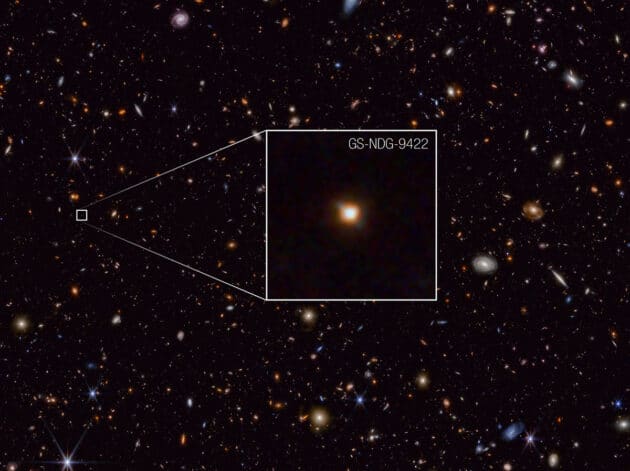
Web view of galaxy “GS-NDG-9422 (9422)”. (Click on the center of the image to see an enlarged view.)
Copyright: NASA, ESA, CSA, STScI, A. Cameron (University of Oxford)
OXFORD, UK – Using the James Webb Space Telescope, astronomers have discovered a galaxy with a strange light signature in early space. They attribute this to the fact that the galaxy’s gas outshines its stars. Discovered about a billion years after the Big Bang, the galaxy may now represent a missing stage in evolution between the universe’s first stars and familiar galaxies.
Like the team led by Alex Cameron of Oxford University who is currently in the specialist journal Monthly Notices of the Royal Astronomical Society (DOI: 10.1093/Manras/Stay1547) The spectroscopic analysis of the galaxy “GS-NDG-9422 (9422)” is as bizarre as the purpose for which the Webb telescope was designed, the astronomer said. “The James Webb Space Telescope is designed to reveal entirely new phenomena in the early universe, which will help us understand how cosmic history began,” the astronomer said.
Cameron, in collaboration with a team led by theorist Harley Katz, discovered that computer models of cosmic gas clouds are heated so much by super-hot, massive stars that the gas glows brighter than the stars, matching Webb's observations almost perfectly.
“It looks like these stars must be much hotter and more massive than we see in the local universe, which makes sense because the early universe was a very different environment,” Katz said.
In the local universe, typical hot, massive stars have temperatures between 40,000 and 50,000 degrees Celsius. However, Galaxy 9422 now contains stars that are hotter than 80,000 degrees Celsius.
Scientists believe that during a brief period of intense star formation, the galaxy is in a dense gas cloud that produces a large number of hot, massive stars. The gas cloud is exposed to so many photons of starlight that it glows very brightly.
www.borderscience-aktuell.de
+ here you can do it GreWi's free daily newsletter Request +
Such a nebulous gas outstripping the stars is particularly interesting because it was expected to occur in the environments of the first generation of stars in the universe, which astronomers classify as Population III stars.
“We know that this galaxy does not have population III stars because Webb’s data show a great deal of chemical complexity. Its stars are still different from those we know — the strange stars in this galaxy could help us understand how galaxies transitioned from primitive stars to the galaxies we know,” says Katz.
Currently, Galaxy 9422 is an example of this stage of development, but there are still many unanswered questions. Are these conditions common or rare in galaxies at this time? What can they even tell us about the early stages of galaxy evolution? Cameron, Katz, and their fellow researchers are actively working to identify additional galaxies to expand this number and better understand what happened in the universe during the first billion years after the Big Bang.
“It’s a very exciting time to be able to use the Webb telescope to explore this era of the universe that has been inaccessible before,” Cameron said. “We’re just at the beginning of new discoveries and insights.”
More news on this topic
Chemical remains of the first stars to be discovered on May 4, 2023
Evidence of Star Formation 250 Million Years After the Big Bang May 17, 2018
Did Radio Astronomers Pick Up a Signal From the First Stars? May 28, 2018
Research source: ESAwebb.org
© borderforschung-aktuell.de






More Stories
Exploding Fireball: Find the meteorite fragments
Neuralink's competitor lets blind people see again with an implant
A huge meteorite has hit Earth – four times the size of Mount Everest